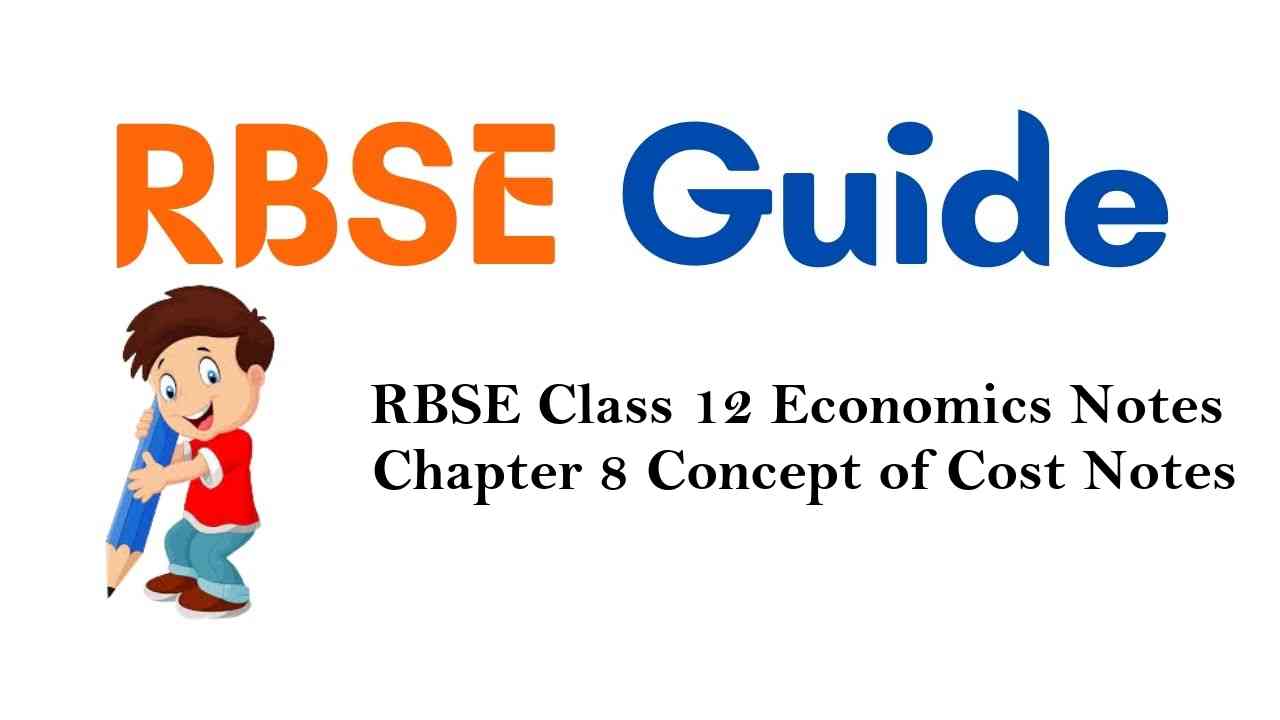Rajasthan Board RBSE Class 12 Economics Notes Chapter 8 Concept of Cost
The expenditure made by a firm on the inputs it uses to produce its product, is called cost in terms of economics.
The term ‘cost’ is used in economics in many connotations. Generally, production cost is of three types :
- monetary cost
- real cost
- opportunity cost.
On basis of accounting, costs are divided into two parts :
- Explicit or clear costs
- implicit or unclear costs.
Monetary cost includes the cash spent in producing a product, i.e. payment of returns of means, etc.
The real or social cost includes all those sufferings and sacrifices, which the society bears during production, indirectly, i.e. dust, smoke, noise, etc.
Opportunity cost is that minimum returns of a means, which it can obtain due to its best alternative use.
Explicit or clear costs are those which are included in the accounts of the firm. Implicit or unclear costs are those which are not included in the accounts of the firm, i.e. labour of owner, own vehicle, own capital, etc.
Costs are also classified according to time period – Short-term costs, long-term costs. Short-term costs include-total fixed costs, total variables costs, total costs, averagte fixed costs, average variable costs, marginal costs, etc.
![]()
Long-term costs include – long-term average costs and long-term marginal costs.
Total fixed costs remain constant in all stages of production.
Total variable costs are the total expenditure done on variable means.
Total cost = Total fixed cost + Total variable cost [TC = TFC + TVC]
Average cost = Sum of average fixed cost and average variable cost [AC = AFC + AVC or AC = \(\frac { T }{ Q } \)
Marginal Cost – The increase in total cost of a firm in short-term to produce one
When average cost decreases, the marginal cost is less than average cost. \(MC=\frac { \triangle TC }{ \triangle Q } \)
When average cost is minimum, the marginal cost curve intersects the average cost curve and crosses above it.
When average cost increases, marginal cost is greater than average cost.
With rise in quantity of production, the average fixed cost decreases continuously. In long term, there is no fixed cost.
![]()
Important Glossary
- Cost : The returns given to the factors of production is the cost of production.
- Monetary Cost: The cash expenditure done by production in manufacturing its product is called monetary cost, i.e. returns on means of production.
- Real or Social Cost : This cost includes all the sufferings and sacrifices which the society bears during production, i.e. dust, smoke, noise, etc.
- Opportunity Cost : It is the minimum return of the individual means which it can obtain for its best alternative use.
- Explicit Cost: Those costs which the producer bears on expenditure for buying various means, i.e. cost of raw material, wages of labourers, interest on borrowed capital, etc. These costs are entered in the producer’s accounts.
- Implicit Cost : When a producer uses his personal inputs in production, for which he does not have to pay anything, these are called implicit costs, for example – use of his own car, his own capital, furniture, etc.
- Total Cost : The amount spent by a firm to produce a certain quantity of a product, is called total cost.
- Average Cost : Average cost is obtained by dividing the total cost of a firm by the number of manufactured products. Average cost is the per unit cost.
- Marginal Cost : This is the cost of marginal unit produced by a firm. The increase in total production caused by increasing the cost of production by one unit is the marginal cost.
- Fixed Cost : The amount spent on fixed means in short term is called fixed cost. This is not affected by change in production.
- Variable Cost: The amount spent on variable means is called variable cost. It increases and decreases along with change in quantity of production.
